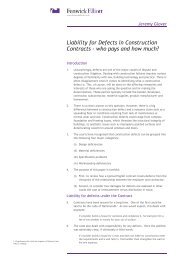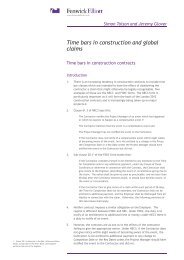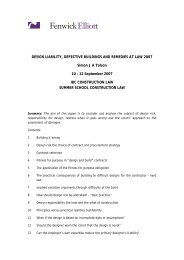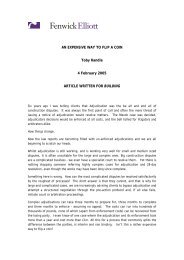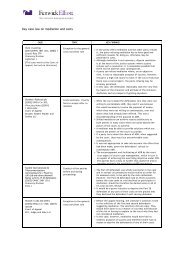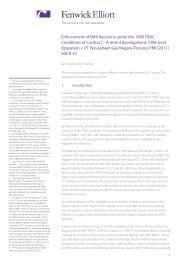Standard forms: JCT 2005, NEC3 and the Virtual ... - Fenwick Elliott
Standard forms: JCT 2005, NEC3 and the Virtual ... - Fenwick Elliott
Standard forms: JCT 2005, NEC3 and the Virtual ... - Fenwick Elliott
Create successful ePaper yourself
Turn your PDF publications into a flip-book with our unique Google optimized e-Paper software.
<strong>St<strong>and</strong>ard</strong> <strong>forms</strong>: <strong>JCT</strong> <strong>2005</strong>, <strong>NEC3</strong> <strong>and</strong> <strong>the</strong> <strong>Virtual</strong> Contract<br />
www.fenwickelliott.co.uk<br />
The mission statement is often <strong>the</strong>n <strong>the</strong> result of <strong>the</strong> partnering workshop, which simply<br />
sits alongside <strong>the</strong> contract between <strong>the</strong> parties. It is an attempt to capture <strong>the</strong> culture of<br />
co-operation, collaboration <strong>and</strong> transparency between <strong>the</strong> parties in order for <strong>the</strong>m all to<br />
achieve <strong>the</strong>ir goals, such as early completion of a high quality project, <strong>and</strong> a reasonable<br />
profit margin. Partnering is essentially a management process that seeks to establish a<br />
way in which <strong>the</strong> parties will carry out <strong>the</strong>ir contractual obligation. From this perspective<br />
it is easy to see how a simple non-contractual partnering charter or mission statement can<br />
be used on any contract regardless of <strong>the</strong> st<strong>and</strong>ard form. As a result <strong>the</strong> <strong>JCT</strong> <strong>and</strong> <strong>the</strong> NEC<br />
have produced partnering options that can quite simply be used alongside <strong>the</strong>ir st<strong>and</strong>ard<br />
form contracts, which continue to regulate <strong>the</strong> rights <strong>and</strong> obligations between <strong>the</strong> parties.<br />
The first of <strong>the</strong>se was <strong>the</strong> NEC partnering option X12. It formally recognises that <strong>the</strong> parties<br />
have entered into a partnering arrangement, but at <strong>the</strong> same time recognises expressly<br />
that <strong>the</strong> NEC option X12 does not create any legally enforceable contractual obligations<br />
between <strong>the</strong> partners o<strong>the</strong>r than <strong>the</strong> parties to <strong>the</strong> contract.<br />
NEC option X12 anticipates that <strong>the</strong>re will be a partnering workshop, <strong>and</strong> <strong>the</strong>n seeks to<br />
develop common information systems as well as processes for design development, value<br />
engineering, value management <strong>and</strong> risk arrangements.<br />
The NEC option X12 was possibly one of <strong>the</strong> first st<strong>and</strong>ard <strong>forms</strong> available for noncontractual<br />
partnering arrangements. More recently <strong>the</strong> <strong>JCT</strong> has also issued a practice<br />
note for use on a single project (<strong>JCT</strong> practice note 4). It is once again drafted to work<br />
alongside <strong>the</strong> existing <strong>JCT</strong> <strong>St<strong>and</strong>ard</strong> Forms of Contract <strong>and</strong> promote a collaborative<br />
working, much like NEC option X12.<br />
The practice notice is relatively short setting out how <strong>the</strong> parties are to interact <strong>and</strong> identify<br />
four objectives for <strong>the</strong> partnering team to achieve:<br />
1) Delivery,<br />
2) People,<br />
3) Teamwork, <strong>and</strong><br />
4) Commercial.<br />
The <strong>JCT</strong> charter states that <strong>the</strong> parties are to act in a co-operative manner, fairly towards<br />
each o<strong>the</strong>r <strong>and</strong> to avoid dispute by adopting a no blame culture. These terms are once<br />
again not intended to create any legal enforceable obligations between <strong>the</strong> signatories<br />
to <strong>the</strong> charter. The <strong>JCT</strong> charter has now been replaced by <strong>the</strong> <strong>JCT</strong> <strong>2005</strong> Framework<br />
Agreement (Binding <strong>and</strong> Non-Binding).<br />
Performance indicators are to be established in order for <strong>the</strong> partnering team to measure<br />
whe<strong>the</strong>r it is achieving <strong>the</strong> full objectives set out in <strong>the</strong> charter. Given that <strong>the</strong> charter<br />
is non contractual, <strong>the</strong>re is little that any party can do if <strong>the</strong> partnering team fails to<br />
establish <strong>the</strong> key performance indicators, or indeed work in a co-operative manner. That,<br />
however, in itself emphasises <strong>the</strong> need for <strong>the</strong> parties to embrace partnering as a sensible<br />
management process which will help all of <strong>the</strong>m to achieve <strong>the</strong>ir commercial goals if it<br />
is to work in practice. Whilst contracts are <strong>the</strong>re to establish <strong>the</strong> rights <strong>and</strong> obligations of<br />
<strong>the</strong> parties, <strong>the</strong>y are also <strong>the</strong>re to provide recourse to one party for breach by <strong>the</strong> o<strong>the</strong>r.<br />
Once <strong>the</strong> relationship between <strong>the</strong> parties has deteriorated to that extent that <strong>the</strong> parties<br />
are relying upon <strong>the</strong> strict terms of <strong>the</strong> contract <strong>the</strong> trust <strong>and</strong> co-operation required for<br />
partnering to work will have expired.<br />
25




